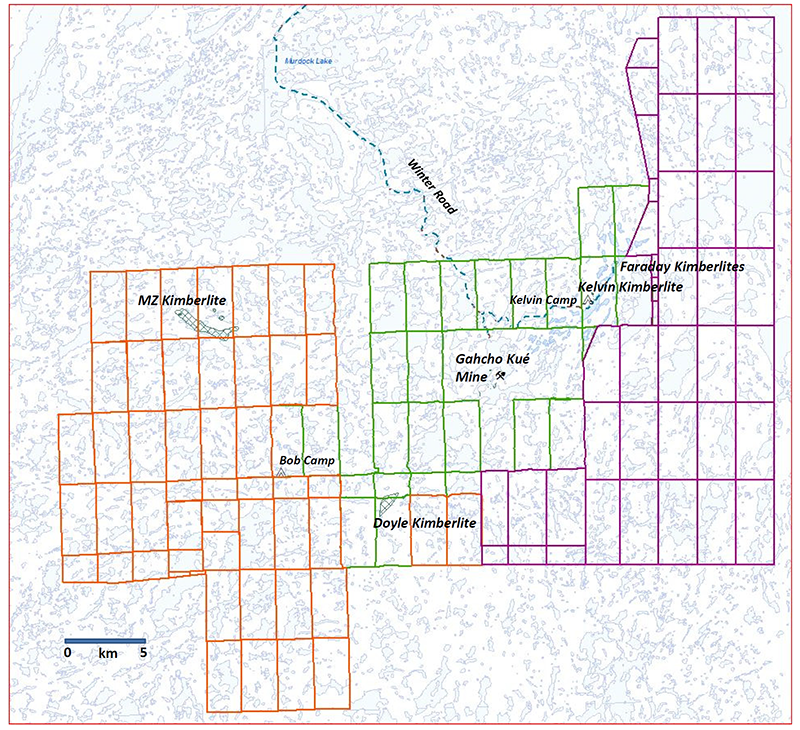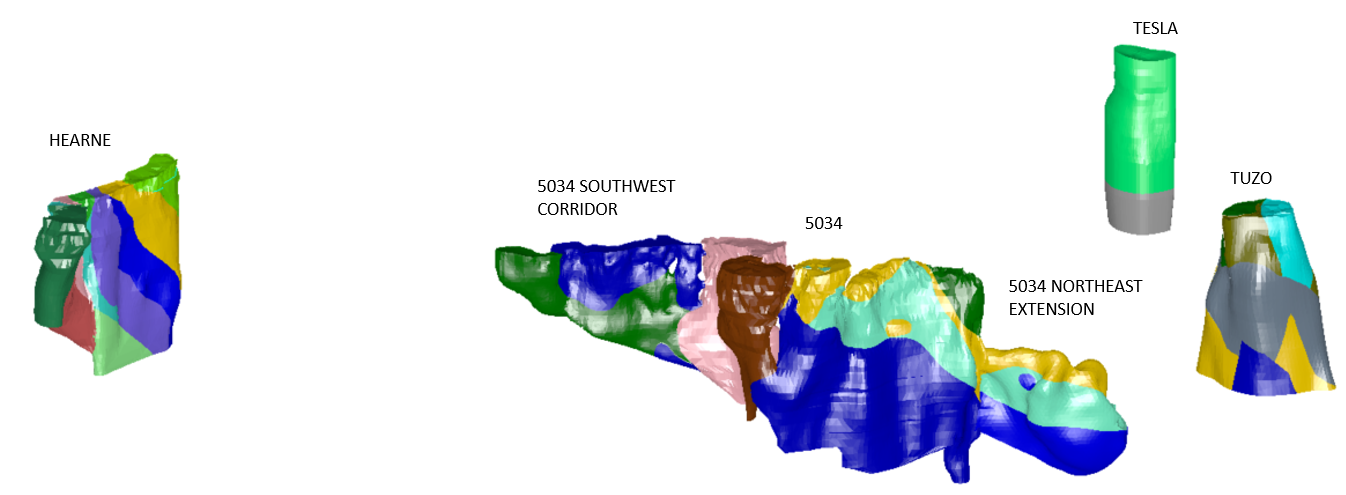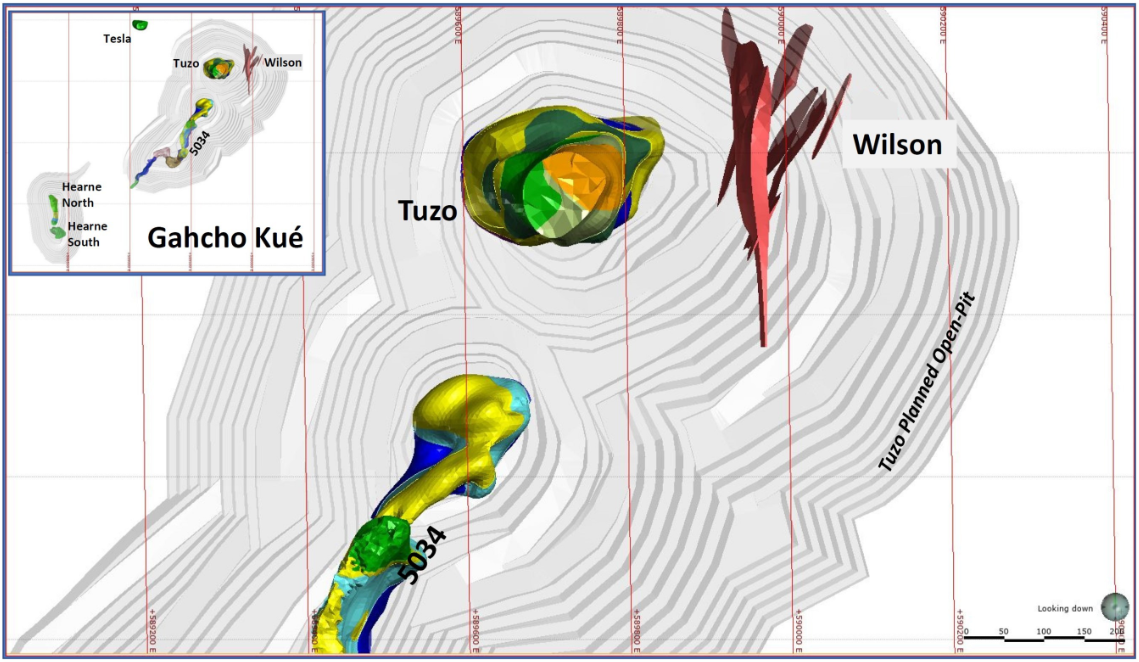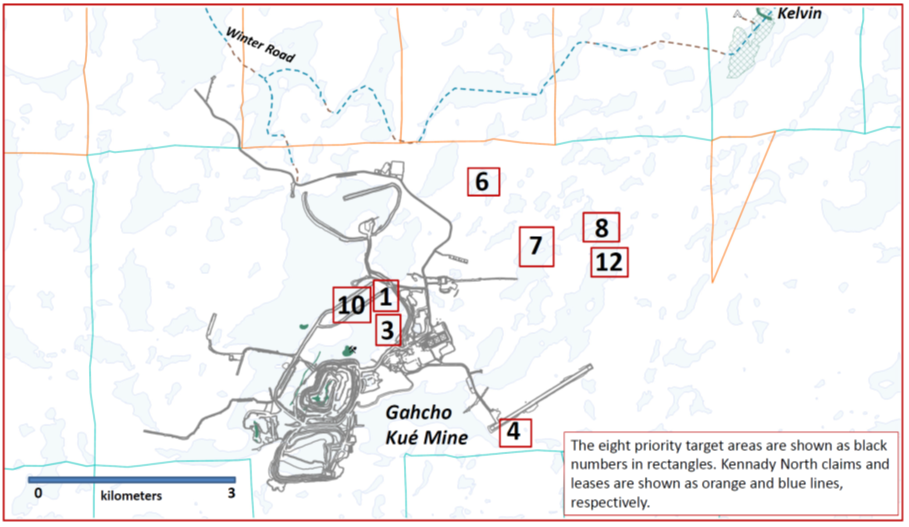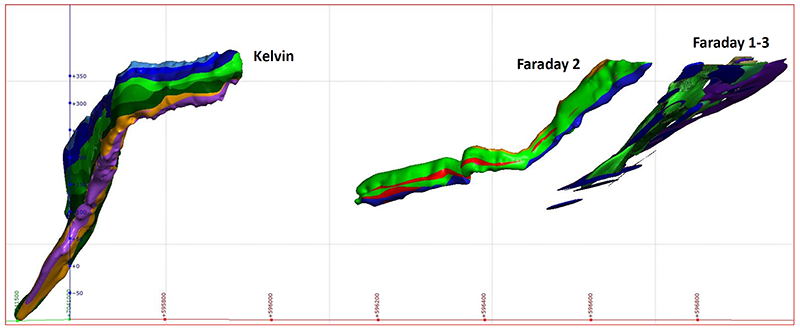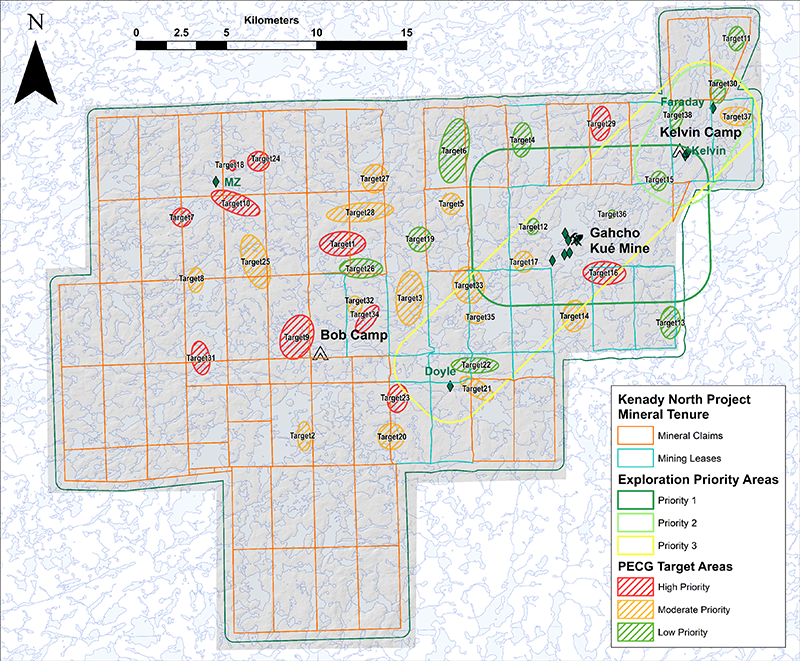Exploration
Category 2 - Two layered pictures
Category 3 - Three Column text
Mountain Province has two active exploration programs that are focused on the discovery of new kimberlites to add to the Company’s diamond production. Both are located in the Northwest Territories of Canada, 300 km east-northeast of Yellowknife, on the traditional territories of Tłįchǫ, Dene, and Métis people.
The Gahcho Kué Joint Venture (‘GKJV’) with De Beers Canada covers 5,216 hectares of mining leases that includes the Gahcho Kué Mine. Exploration within the GKJV focuses on near-mine and brownfields discoveries that can extend the life of the mine.
De Beers Canada is the operator of the exploration programs for the GKJV, with Mountain Province as a 49% partner. Mountain Province has developed a very proactive relationship with De Beers, with regular meetings held to discuss exploration plans and collaborative workshops to prioritize new targets for drilling. Subsequent to our collaboration the joint venture found the Wilson kimberlite in 2019; the first new kimberlite discovery on the GKJV leases in 20 years.
The Company is also actively exploring on the Kennady North Project (‘KNP’), which consists of 106,202 hectares that completely surround the GKJV leases. Mountain Province is the operator of the exploration programs on the KNP.
Five kimberlites have been discovered on the KNP, with three having NI 43-101 resource estimates. These resources are within ten kilometers of the Gahcho Kué Mine.
Category 4 - Centered Video
Category 5 - Three Column text
Both projects are located in the southeastern portion of the Slave Archean Craton, an ancient nucleus of thick cratonic rocks that also host the Diavik, Ekati, and Snap Lake diamond mines located to the north-northwest. The oldest rocks in the craton are granites and gneisses that are 2.55-4.03 billion years old, with overlying metasedimentary and metavolcanic units that have been metamorphosed to amphibolite-facies lithologies. These rocks have subsequently been intruded by diabase dykes and sills that range in age from 2.3 to 0.7 billion years.
The kimberlites that comprise the mine and resources in the region were emplaced about 0.5 billion years ago, making them some of the oldest economic kimberlites in the world. Much of the geologic record since their emplacement has been erased through erosion, with the most recent erosional event being continental glaciation that ended roughly 8,000 years ago. As a consequence, the upper crater portions of both the GKJV and KNP kimberlites have been eroded, and only the diatreme and hypabyssal portions remain. Erosion during the ice age was important, as unique minerals that form with diamond but are more abundant could be found in the glacial deposits left by the advancing ice sheets. These ‘indicator’ minerals could be tracked back to their kimberlite source by carefully sampling the glacial deposits. All of the kimberlites in the GKJV and KNP areas were discovered with the support of indicator minerals.
At the Gahcho Kué Mine there are presently three kimberlites in the mine plan; 5034, Hearne, and Tuzo. The 5034 kimberlite is the largest and most complex both in terms of its shape and lithologies. The Kennady North Project hosts five diamond-bearing kimberlites, Kelvin, Faraday 2, Faraday 1-3, MZ, and Doyle. These kimberlites are unconventional in both their shape and nature of emplacement relative to younger ‘carrot-shaped’ kimberlites as seen at Ekati and Diavik, but they can host significant volumes of kimberlite with economic diamond contents.
All of the kimberlites that are part of the mine, or that are an estimated resource, lie within the Kelvin-Faraday Corridor, which is a northeast-trending structural feature that appears to have allowed the greatest volumes of kimberlite to reach the surface at the time of their emplacement. Kimberlites do occur outside of the Kelvin-Faraday Corridor, such as the MZ kimberlite that is located twenty kilometers west of the mine. MZ is diamond-bearing, but has not seen any further exploration work since 2015.
Category 7 - Three Column text
Economic kimberlites on the GKJV were first discovered in the mid-1990’s and most of these discoveries are now part of the Gahcho Kué Mine. The large volumes of kimberlite with grades exceeding one carat per tonne led to a rapid development of these discoveries to become the Gahcho Kué Mine, so for several years no exploration took place on the GKJV. Near-mine and brownfields exploration started again in 2017 and led to the discovery of additional kimberlite within the known ore bodies.
At kimberlite 5034, the new discoveries include the Southwest Corridor and the Northeast Extension, and for the Hearne kimberlite additional material was discovered between what was initially considered two separate lobes. These new additions have added to the life of the Gahcho Kué Mine.
The present configuration of the kimberlites is shown in the 3D image below, with the blue colors indicating hypabyssal kimberlite and other colors indicating breccia units. The view is to the northwest, and the distance from Hearne to Tuzo is roughly three kilometers.
In 2019, exploration focused on testing for a connection between 5034 and the Tuzo kimberlite, resulting in the discovery of the Wilson kimberlite. Wilson is elongated north-south and has roughly vertical contacts with country rock along its length. A greater volume of kimberlite is present to the north, and the kimberlite also remains open to the north.
The Wilson kimberlite shows no connection with the Tuzo or 5034 kimberlite and is the first new distinct kimberlite discovery on the GKJV leases in 20 years.
Wilson is named after Alice Evelyn Wilson, Canada’s first female geologist, the first woman elected as a Fellow of The Royal Canadian Geographical Society (1930) and the Royal Society of Canada (1938) and the first Canadian woman to be admitted to the Geological Society of America (1936). This followed in the tradition (with the exception of 5034), of naming the kimberlites after scientists that contributed to a better understanding of the earth. The Hearne kimberlite is named after Samuel Hearne, an 18th-century explorer who was the first European to make an overland excursion across northern Canada to the Arctic Ocean. The Tuzo kimberlite is named after J. Tuzo Wilson, a Canadian geophysicist who contributed greatly to the theory of modern-day plate tectonics. Though not part of the present mine plan due to its smaller size, Tesla is named after Nikola Tesla, the inventor of modern alternating current electricity. A small kimberlite blow to the northwest of Tuzo is named Curie after Marie Curie, the first woman to win a Nobel Prize for her research in radioactivity.
Located only 200 meters east of the Tuzo kimberlite, the Wilson kimberlite lies within the open pit mine plan for Tuzo and will contribute to extending the mine life at Gahcho Kué. A plan view of the Wilson kimberlite relative to Tuzo and 5034 is shown in the image below. Wilson is shown in red as the lithological units within it are not fully resolved.
In 2018, superconducting quantum interference device (‘SQUID’) data were collected over the lease area. The SQUID results, as well as older historical mineral, structural, magnetic, EM and gravity data, were reviewed at a joint De Beers/Mountain Province workshop in August 2019. Thirteen target areas were identified, and an additional 116 line-km ground gravity and 128 line-km of OhmMapper data were collected between October 2019 and February 2020
In a second workshop held in February 2020, eight of the 13 target areas were ranked for drilling. The winter 2020 drill program planned for 2,100 meters of core drilling over an eight week period, but the program was greatly reduced due to the COVID-19 pandemic. Only targets 8 and 12 were drill-tested. Two drillholes were completed on each of the targets for a program total of 549 meters, with no kimberlite encountered. A location map showing the eight priority target areas is provided below.
Category 8 - full width photo/small overlapping
Category 6 - Single Left Photo
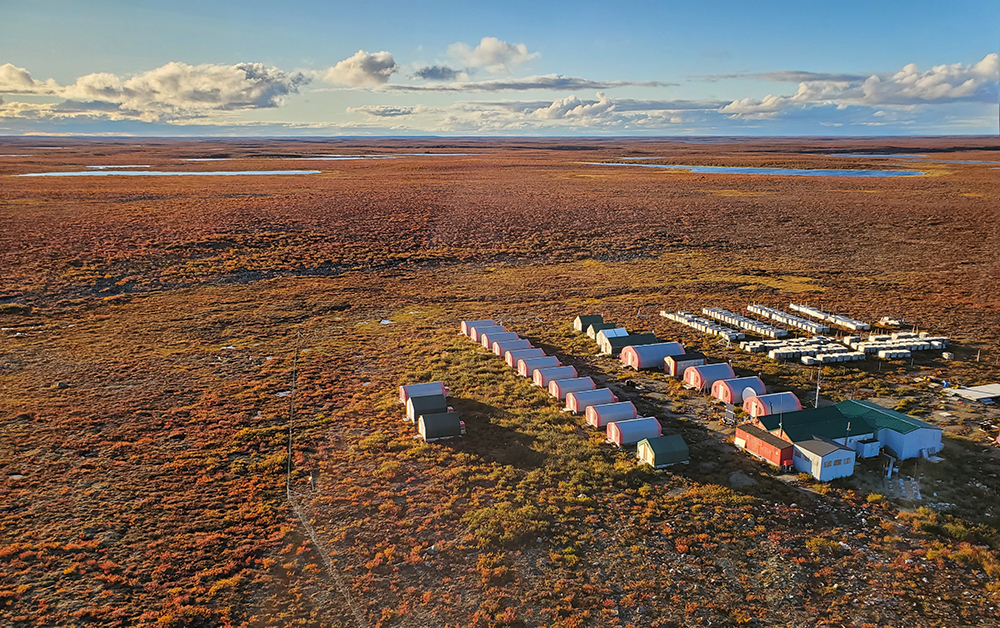 |
Category 9 - Three Column text
The areas that cover the Kennady North Project were subjected to diamond exploration programs by several operators over the period from 1992 to 2003, with the latter years covered by De Beers Canada. During their activities, they discovered short intersects of hypabyssal kimberlite and kimberlite breccias that appeared to be limited in extent. Following with the tradition of the Tuzo, Tesla, and Hearne kimberlites, they were named after the eminent physical scientists Lord Kelvin and Michael Faraday.
After the GKJV was formed with the intent to advance the larger kimberlites to a mine, the Kelvin and Faraday kimberlites were spun-off into a new company called Kennady Diamonds. Renewed exploration from 2012-2017 under Kennady led to advancements in understanding the Kelvin and Faraday bodies. Significant combined geophysics and drilling resulted in the discovery of significant tonnages of kimberlite at both Kelvin and Faraday, and they are now resources under the definition of NI 43-101.
The Kelvin and Faraday kimberlites are different from the more common, vertically-sided shapes that occur in the GKJV area and elsewhere in the world. Determining their orientation through drilling was sufficient to define them as resources has placed Kennady Diamonds at the forefront of discovering more bodies of this nature.
Kennady Diamonds was acquired by Mountain Province Diamonds in early 2018 and is 100%-funded by the Company in their exploration and development efforts. Since acquisition, the Company has advanced the resources at Kelvin and at Faraday 2, and is in the stages of permitting and consultations with the intent of incorporating them into the Gahcho Kué Mine. Presently however, there is no formal agreement between Mountain Province and De Beers with respect to these assets.
The 3D image below is looking to the north, with blue-purple colors indicating hypabyssal kimberlite and other colors indicating kimberlite breccias. The distance from Kelvin to Faraday 1-3 is roughly three kilometers.
In 2018, we began a review of all historical exploration data for the KNP, with the intent to apply the experience gleaned from developing the Kelvin and Faraday resources. We also engaged some new technologies, using a combination of LIDAR data and modern mapping of glacial geology to develop areas of priority for further exploration. These priority areas are shown as ovals on the image below. This work was conducted prior to acquisition of the new claims to the east, and these claims will be assessed in similar fashion with respect to historical data and new methodologies.
Although exploration activities at Kennady North have been reduced due to the COVID-19 pandemic, there is still a great potential for new kimberlite discoveries. Field-based exploration programs are presently replaced with detailed desk-top studies of our extensive database to refine the ranking of our exploration target areas. The objective is that when the implementation of field-based programs post-COVID is again possible, we will again optimize our experience with additional new kimberlite discoveries.
Category 10 - Three Column text
The summaries above are provided as an overview of exploration at the Gahcho Kué Mine. For more detailed information, please access the NI 43-101 Technical Reports on www.sedar.com, or download them from the links provided below.
Gahcho Kue Mine NI 43-101 Technical Report - March 1 2020
Gahcho Kue Mine NI 43-101 Technical Report - March 16 2018
Gahcho Kue Mine NI 43-101 Technical Report - March 31 2014
Sign up to our Newsletter for the latest news and press notifications sent directly to your email.
